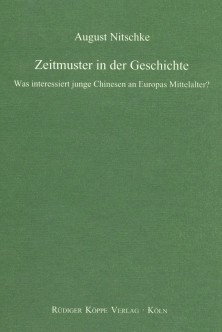
Zeitmuster in der Geschichte
Was interessiert junge Chinesen an Europas Mittelalter?
Author: August Nitschke †.
2004432 pp.
Text language(s): German
Format: 160 x 240 mm
890 g
Hardcover
€ 59.80
Buy 'Zeitmuster in der Geschichte' as a downloadable PDF document directly from our online shop »
Order 'Zeitmuster in der Geschichte' as print edition »
Historical studies increasingly draw the intention to parallelisms between the course of politics, economics, law and the motions in physical works, art, dance and sports. They seem to be connected with socially and periodically typical ways of perception which are not derivable from the mentality of a society. Recent, biologically based studies lead to the knowledge that these ways of perception originate from experience within time which determine the concept of a society’s future. Within this experience, humans are getting used to certain time patterns which constantly change from one era to another while following their own laws.
At young chinese historians’ request from the Jilin Province, the author examined these results on the basis of texts, works of art and movement reconstructions of the Middle Ages and the twentieth century. He came to the conclusion that the students of Changchun do not know their own traditions any more. From Marxism they only retained the demand to justify every event and every structure of the past by causal means.
They argument differently but always very emotionally against the descriptive historical science. The often very critical, but always cheerful dialogues are represented on the basis of the author’s written notes. The arguments of the students, which are farmers’ as well as graduates’ children, only became comprehensible when the author got to know their forms of living in a big Chinese city.
The superabundant supply of products there, the surprisingly reckless traffic, the countless little restaurants and the daily evening dance on a main street create an atmosphere of enthusiasm for one’s work and a readyness to depart which is supported by women directing the professional life, which is possible in spite of bureaucratic restrictions and which influence the historical questions of the students. This is illustrated by the everyday events which are woven into lighthearted and very personal stories.
Under thse links you will find further publications about China and Mongolia:
Cross-reference:
- A Dagaare-Cantonese-English Lexicon for Lexicographical Field Research Training
(ISBN 978-3-89645-009-8 ) - Ethnographic Encounters
(ISBN 978-3-89645-512-3 ) - Sprache und Identität der Mongolen Chinas heute
(ISBN 978-3-89645-222-1 ) - Transitivität und Verbvalenz im Swahili
(ISBN 978-3-89645-712-7 ) - Ögedei mergen qan-u üliger — Die Geschichte vom weisen Qan Ögedei
(ISBN 978-3-89645-198-9 )
Reviews
Unser Mittelalter schildert Nitschke mit neuartigen, überraschenden Thesen und Bildern. Er warnt vor der Illusion, Handeln und Denken früherer Menschen zu verstehen, wenn man ihre Texte meint übersetzen zu können. So zeigte er den Studenten, wie Quellenaussagen in das Weltbild und in die Zukunftsvorstellungen des Autors eingebettet sind und von diesen her zu verstehen sind. Zur Erschließung dieser Vorstellungen sind die in den Kunstwerken der Epoche geschilderten Gesten und Haltungen hilfreich, die der Autor seit Jahrzehnten erforscht hat. [...]
Eine an den sich wandelnden Zukunftserwartungen der Menschen orientierte Geschichte des Mittelalters gab es bisher nicht. Sie wird hier – unter Einbeziehung der Kritik der Studenten – höchst lebendig entwickelt. Aus dem Bericht, wie der Autor bei jungen Chinesen das Interesse am europäischen Mittelalter zu wecken weiß, kann der Leser faszinierende Bilder und Deutungen von Hauptphänomenen dieser Epoche gewinnen.
Ekkehard Eickhoff in Damals. Das Magazin für Geschichte und Kultur, 4/2006, 46-47
| « back | Print version | [top] |
 Books
Books Audio
Audio Biographies
Biographies Series
Series Festschrifts
Festschrifts Journals
Journals